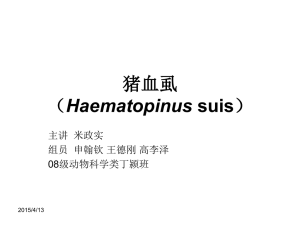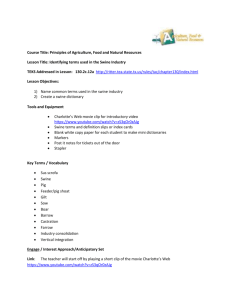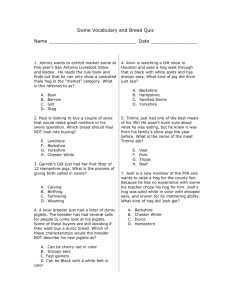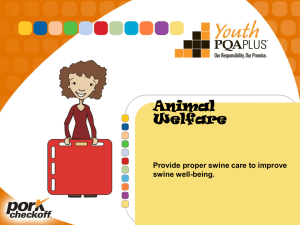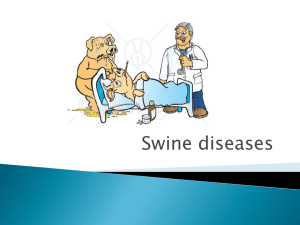File
advertisement
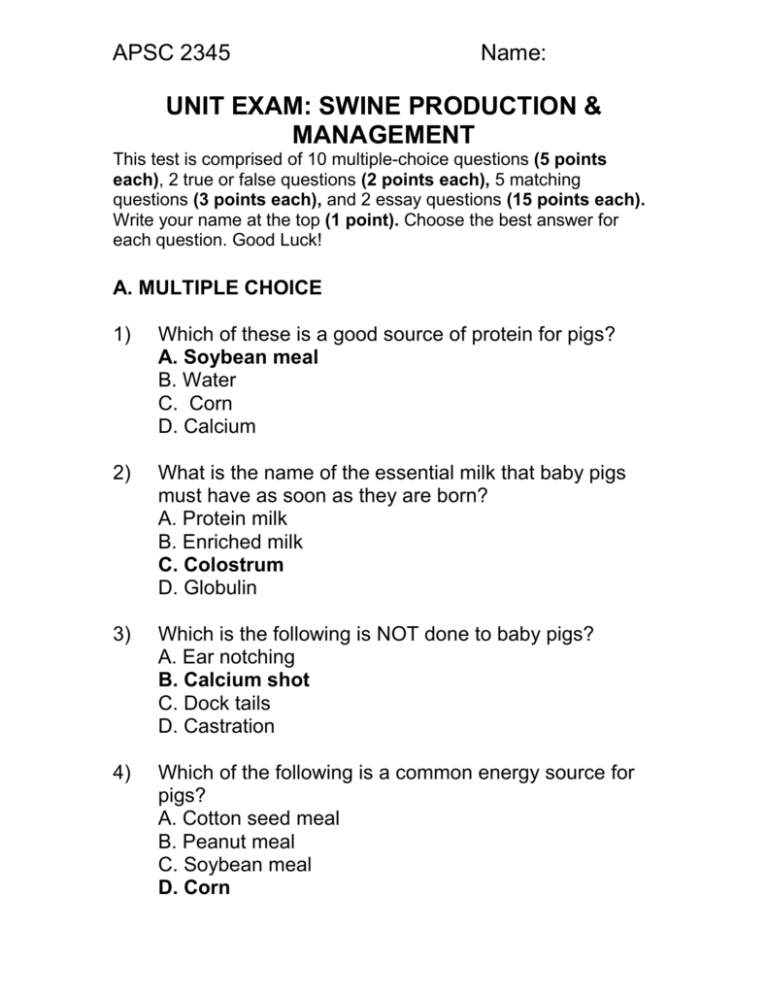
APSC 2345 Name: UNIT EXAM: SWINE PRODUCTION & MANAGEMENT This test is comprised of 10 multiple-choice questions (5 points each), 2 true or false questions (2 points each), 5 matching questions (3 points each), and 2 essay questions (15 points each). Write your name at the top (1 point). Choose the best answer for each question. Good Luck! A. MULTIPLE CHOICE 1) Which of these is a good source of protein for pigs? A. Soybean meal B. Water C. Corn D. Calcium 2) What is the name of the essential milk that baby pigs must have as soon as they are born? A. Protein milk B. Enriched milk C. Colostrum D. Globulin 3) Which is the following is NOT done to baby pigs? A. Ear notching B. Calcium shot C. Dock tails D. Castration 4) Which of the following is a common energy source for pigs? A. Cotton seed meal B. Peanut meal C. Soybean meal D. Corn 5) Which feed has the least amount of protein? A. Starter B. Grower C. Finisher D. Pre-starter 6) Which state is the largest pork producing state in the U.S.? A. Iowa B. Virginia C. North Carolina D. Mississippi 7) Maternal breeds, such as ________ and ________ are known for the excellent mothering abilities. A. Yorkshire and Berkshire B. Durocs and Berkshires C. Spotted and Durocs D. Poland China and Landrace 8) What are the two main types of swine production systems? A. Commercial and Farrow to Finish B. Purebred and Feeder pig C. Purebred and Commercial D. Start and Finish 9) Which breed of swine is from Denmark but imported to the U.S. in 1934 A. America Landrace B. Yorkshire C. Duroc D. Hampshire E. Berkshire 10) Which are the types of housing used in swine production? A. 1 & 2 Stage B. 1, 2, 3 Stage C. 2, 3, 4 Stage D. 1 Stage E. 2 & 3 Stage B. TURE OR FALSE 1. __T__ A boar is a mature, intact male pig. 2. __T__ Swine consumption has remained steady for the past 20 years. C. MATCHING Match each breed with its characteristic. 1. __E__ Chester White A. Red color, fast-growing 2. __A__ Duroc B. White color, erect ears, large litters 3. __D__ Hampshire C. White color, large litters, lots of milk 4. __B__ Yorkshire D. Black with white belt, lean carcass 5. __C__ Landrace E. White color, drooped ears, excellent mothers D. ESSAY 1. Name 3 types of floors used in hog farms and an advantage or disadvantage of each. Then explain why is important to have efficient flooring in a hog facility. - Solid- cheapest and concrete; manure management hard - Partially slotted- combination of both, cheap; average manure management - Totally slotted- hard to control temperature; almost eliminates manure management It is important to have efficient and effective flooring so the pigs don’t slip, fall or get hurt. It is also important in order to manage manure and hygiene. 2. Name 4 characteristics that would make an ideal place for a hog facility. Then draw below your own hog farm incorporating land, water, food, facility, fencing and of course a pig. - Four characteristics that would make an ideal place for a hog facility include: rural area, expansion option, water and electricity accessibility, and appropriate runoff. The learning objectives for my lesson plans tie into my unit plan accordingly. For the first lesson on swine breeds the learning objectives, include: identifying the major breeds of swine by body characteristics and qualifications, defining gender and maturity terms associated with swine, and understanding the origin and history of common swine breeds. For the second lesson on feeding and management of swine, the learning objectives include: defining the different types of swine production systems, describing the distinctive feeding programs for different stages of a pigs life cycle, and identifying the accepted types of management practices for pigs. For the third and final lesson, swine housing and equipment, the learning objectives include: describing facilities required for swine production, identifying equipment required for swine production, and learning how to distinguish pig each notches. My unit plan objectives cover: identifying the most common breeds of swine including: characteristics, history and qualifications, understanding the different types of swine feeding and management practices and describe the required housing and equipment used in swine production. Each of my unit plan objectives explain a broad clarification of the detailed lesson plan objectives. The first unit plan objective, identifying the most common breeds of swine including: characteristics, history and qualifications ties into the lesson plan objectives because it is explaining what the student is going to learn by the end of the lesson. The student should be able to identify major breeds of swine by body characteristics and qualifications, define gender and maturity terms and understand the origin and history of common swine breeds. The second unit plan objective, understanding the different types of swine feeding and management practices connections into the lesson plan objectives because it is a general idea what the student is going to learn by the end of the lesson. The student should be able to define the different types of swine production systems, describe the feeding programs for different stages of a pigs life cycle, and identify the accepted types of management practices for pigs. The third unit plan objective, describe the required housing and equipment used in swine production, connects into the lesson plan objectives because it is describing, in a general sense, what the student is going to learn by the end of the lesson. The student should be able to describe facilities required for swine production, identify equipment required for swine production, and learning how to distinguish pig each notches.



